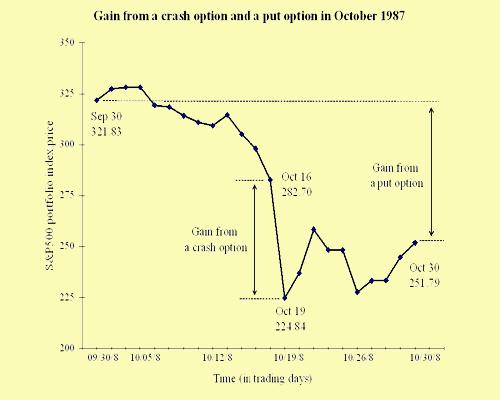

Cet article a reçu le prix du Chicago Board of Trade pour la recherche sur les produtits dérivés.
Risk is one of the most important factors in the management of financial assets. The efficiency of risk management methods such as portfolio insurance is largely undermined during periods of extreme volatility like stock market booms and crashes. The accuracy of portfolio insurance critically depends on the process followed by the market price: the possibility of gap openings, jump movements and unexpected changes in volatility may undermine the strategy during periods of market stress. Moreover, portfolio insurance may be liable to have a destabilizing effect on the market during these periods. In any event, such a dynamic hedging technique has been less used by market participants since the last stock market crash of October 1987.
The contribution of this article is to introduce a new type of financial derivatives called boom and crash options in order to improve the performance of portfolio insurance techniques, especially during periods of market stress. The purpose of crash options for example is to protect the value of a long position against a sharp, large decline in market prices. Portfolio managers could use crash options to limit their extreme downside risk. Crash options complete the spectrum of existing options as they focus on extreme price changes during a short period. In their conception crash options are relatively close to lookback options whose payoff depends on the maximal or minimal price reached by the expiration date. Although lookback options deal with the difference between the price at the expiration date and its maximum or minimum reached during their life-time, crash options deal with the minimal price changes computed over a short period of time.

The main result of the paper is to price and derive a pricing strategy for boom and crash options. Two types of market are considered : a market with few extreme price movements (returns are drawn from a thin-tailed distribution such as the Gaussian distribution) and a market with many extreme price movements (returns are drawn from a fat-tailed distribution).
 The asymptotic distribution of extreme stock market returns
The asymptotic distribution of extreme stock market returns
 Winning in the best and worst of times : boom and crash options
Winning in the best and worst of times : boom and crash options
 From VaR to stress testing : the extreme value approach
From VaR to stress testing : the extreme value approach
 Retour à la liste des publications
Retour à la liste des publications
 Conseil en gestion de portefeuille
Conseil en gestion de portefeuille
 Glossaire de termes financiers
Glossaire de termes financiers